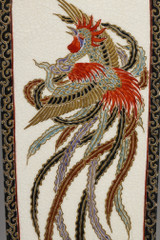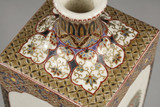A beautiful and rare quadrangular earthenware soliflore vase decorated with polychrome enamels and rakan gold, adorned on the sides with dragons and phoenixes in particularly vibrant colors within a border of flowers and arabesques. Satsuma mark on the underside. The exceptional workmanship and quality of this vase distinguish it from classic Satsuma productions intended for the export market during the Meiji era, which are found on the European market today. Circa: 1880
Satsuma ware originated in 1598 under the influence of Shimazu Yoshihiro, a powerful Japanese lord whose intention was to establish a local pottery industry in Satsuma. For over four hundred years, Satsuma potters developed original ware techniques, making it one of the most prestigious names in Japanese ceramics. This type of ceramic is characterized by the diversity of forms in vases, bowls, lamps, and various decorative objects, which evolved according to the era and the kilns used. For many, Satsuma ceramics evoke images of white-bodied pieces with polychrome decorations enhanced by gilding; indeed, this was the most famous and sought-after style in Western countries at the end of the 19th century. It is called "gold brocade Satsuma" because of the richness of its ornamentation and the systematic use of gold. Its decoration, meticulously crafted down to the smallest detail, can be very elaborate, thanks in particular to the extensive use of gold. Geometric and abstract forms are combined with realistic illustrations such as flowers or birds. The human figure is also very commonly used in a style reminiscent of woodblock prints. The rise to prominence of Satsuma ware began with its export to Western countries. It was in the 19th century that Satsuma porcelain was introduced to the West, notably through World's Fairs. Today, Satsuma ceramics are still produced, encompassing a wide range of techniques and potters located in Kagoshima Prefecture. More than 200 pottery workshops remain faithful to the quality and techniques that have made Satsuma one of the leading names in Japanese ceramics.
Condition report: In excellent condition with its calligraphed box
- Reference :
- 3394
- Width :
- 7 (cm)
- Height :
- 21 (cm)
- Depth :
- 7 (cm)
- Era:
- 19th century
- Style:
- Asian Art
- Materials:
- Earthenware












































